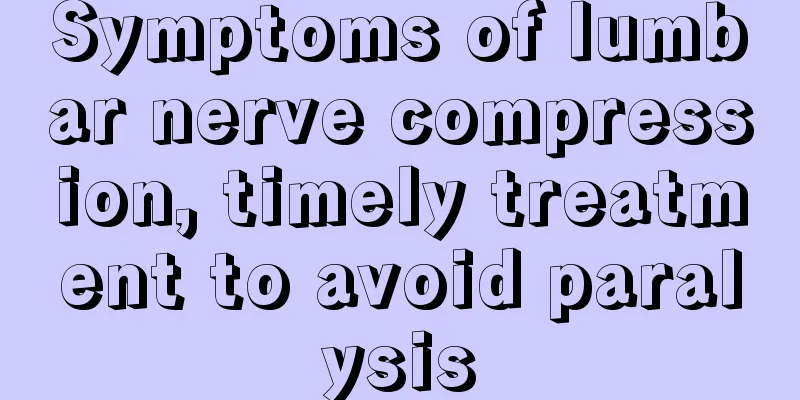Symptoms of lumbar nerve compression, timely treatment to avoid paralysis

|
Our living conditions have improved, but many diseases have become more and more common. Lumbar disc herniation is particularly common now. If symptoms of nerve compression occur, leading to paralysis, it is very serious and requires timely treatment, and it is also important to understand the early symptoms of this disease. 1. Muscle paralysis: If lumbar disc herniation compresses the nerves for a long time, it may cause nerve paralysis or muscle paralysis, and some may also cause intermittent claudication, scoliosis, and sideways curvature. These phenomena can easily cause many inconveniences to patients with lumbar disc herniation, and some may even lose their ability to move. 2. Low back pain: This pain may occur before leg pain or at the same time. The pain is mainly in the lower back or lumbosacral area. The pain is mainly caused by the stimulation of the sinus nerve fibers in the outer layer of the annulus fibrosus and the posterior longitudinal ligament after lumbar disc herniation. The pain of lumbar disc herniation is deep and difficult to locate, and is generally dull, stabbing or radiating pain. 3. Simple lower limb pain: What are the common symptoms of lumbar disc herniation? Although simple pain and discomfort in the lower limbs are rare in lumbar spondylosis, it can still be the first symptom in some chronic degenerative lumbar spondylosis. Some middle-aged and elderly patients with lumbar disc herniation may come to the hospital for simple numbness, soreness or stiffness of the lower limbs. If you only look for the cause in the lower limbs, it is often ineffective, resulting in misdiagnosis and missed diagnosis of lumbar disc herniation. 4. Low back and leg pain: Most patients with lumbar disc herniation have a history of trauma, cold or overwork. At the onset of the disease, patients often first experience varying degrees of low back pain. In mild cases, there is only dull pain and soreness, while in severe cases, patients with lumbar disc herniation are often bedridden and have difficulty turning over. The low back pain gradually eases or disappears after bed rest. After a few days or weeks, you will gradually feel radiating pain in one lower limb, and the lower back pain will worsen when you stand, walk, cough, sneeze, or strain to urinate or defecate. 5. Restricted spinal movement: When the waist is normal, its range of motion is 900 degrees of forward flexion, 300 degrees of extension, 200-300 degrees of left and right lateral flexion, and 300 degrees of left and right rotation. When the lumbar disc herniates and the spine flexes, the front of the disc is squeezed, the posterior space widens, and the nucleus pulposus moves posteriorly, increasing the tension on the protrusion. At the same time, the nucleus pulposus moves upward, pulling on the nerve roots and causing pain. When the waist is extended backward, the protrusion also increases, and the folds of the yellow ligament protrude forward, causing compression of the nerve roots front and back and causing pain, so the pain limits the movement of the spine. |
<<: What to do if you have bad breath due to stomach inflammation? These four points can help you
>>: Early symptoms of lumbar disc herniation, these symptoms are the most typical
Recommend
What are the pros and cons of porcelain teeth?
There are many types of porcelain teeth, each wit...
How long after implantation can pregnancy be detected?
Once the fertilized egg implants in women, the bo...
What to do if you feel dizzy the next day after drinking
It is very common for people to drink at parties ...
Varicose veins on the inner side of the calf
Varicose veins of the lower legs are a very commo...
Experts briefly analyze the main symptoms of liver cancer
It is understood that in China, many people lose ...
What happens if people sleep too much
Sleep is an activity that everyone must perform e...
Skin suddenly becomes itchy and red?
In daily life, we often suddenly experience itchy...
What is the most effective way to prevent gout?
No matter who you are, you should pay more attent...
How to protect the throat
Hot and dry weather is most likely to hurt the th...
How to remove oil stains from clothes
Everyone can have a clean and tidy image, which w...
Is it useful to wash your face with skim milk?
It is definitely useful to wash your face with sk...
What are the contraindications for taking mugwort charcoal?
Mugwort is a relatively common Chinese medicinal ...
Can honey prevent colon cancer?
We know that for a disease, the most important th...
Can I eat bonito if I have constipation
Bonito flakes is a cold-water fish and is usually...
Don’t take supplements blindly, excessive supplements are harmful!
There are many nourishing foods in life, and many...









